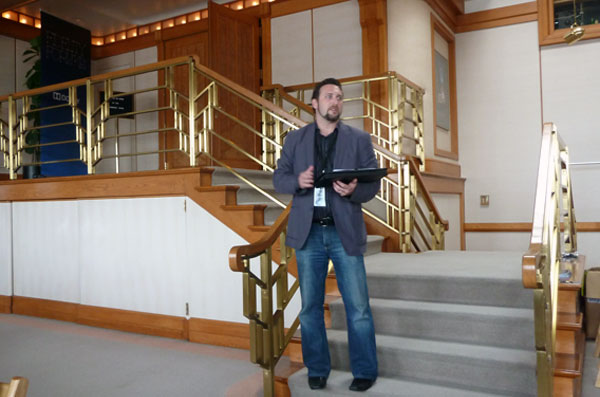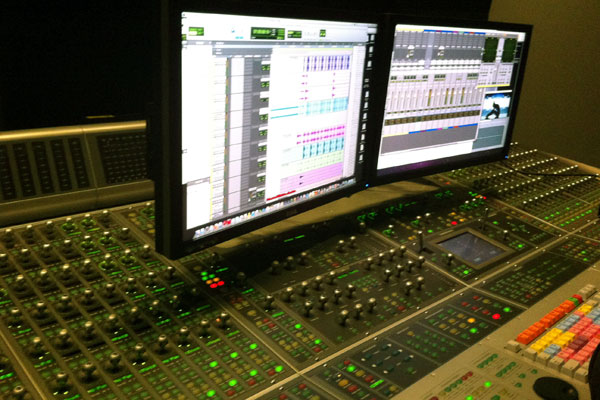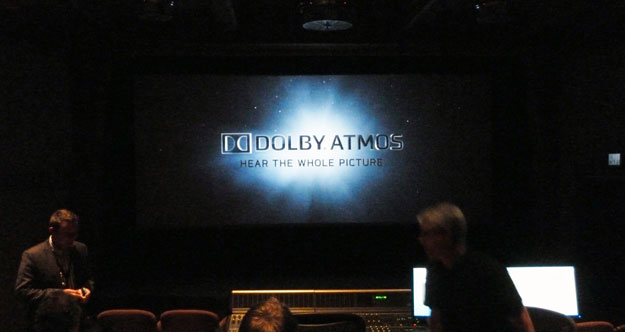Big Picture Big Sound was lucky enough to be in attendance at the Dolby Fidelity Forum 2.0 (not a reference to the number of channels and lack of subwoofer as it turns out) at the company's San Francisco headquarters last week, for two full days of nonstop demonstrations, discussion, and yummy snacks.
First up was the announcement/explanation/exhibition of Dolby TrueHD with Advanced 96K Upsampling, a new option for the studios which when applied to movies and music recorded at the 48kHz sampling rate (the de facto standard for in The Biz) can noticeably enhance the sound quality. Working from the understanding that Blu-ray is the pinnacle of sound and video in the home, the quest here is to make that experience sound the absolute best it can.
This added step in the disc creation process is considered "premastering," applied to 48K soundtracks after the studio's official mix/master, and yet the results are extremely natural with no negative side effects whatsoever that I detected. The upsampled 96K track then simply resides on the disc, and Dolby has a new series of logos and stickers and other indicia to call out Blu-rays with this premium tweak. And, since they're staying well within the Blu-ray specs, this new technology should work with virtually of the gear already out there. In other words, we shouldn't be needing to run out and buy new decks and receivers and cables (although we certainly can if we'd like).
They've worked with the studios, who like it because it makes their product sound its best, and will therefore make consumers happy, again because they are getting a better experience without buying new gear. They might need to re-buy a disc, or just keep their eyes peeled for that 96K Seal of Approval as new releases start hitting.

Dolby taught us quite a bit during our visit about how soundtracks go from theatrical mixes to "near-field" home theater mixes, including dropping the surround levels by 3dB for the home, accomplished with a single button using the modern audio tools of Dolby's own design. Depending upon the studio's and filmmaker's wants and needs, they also sweat different mixes for discrete 7.1, 5.1 and 2.0, not content to merely fold the extra channels down into fewer speakers. They even test their mixes for "Night Mode" or similar dynamic range compression as found on so many consumer products lately.
Throughout our demos we were told that they often create custom samples of popular music and movie titles, some of which we were not at liberty discuss publicly, as some were very early proof-of-concept reels. The self-evidence of the 48-to-96kHz upsampling will vary with the content, but most of the before/after comparisons were quite impressive. In addition to a more spacious soundstage and a clearer high end, the decay of fine, sustained sounds was audibly longer and more detailed, as we would encounter, say, at a live musical performance. Dialogue was also significantly cleaner and easier to understand. Most exciting was the idea that we could essentially hear for the first time audio data that has been there all along in some of our favorite movies, which we now know can sound better than ever.
We had the rare chance to hear the new technology in Dolby's own purpose-built rooms, but readers wanting to audition 96K Upsampling on their own, take note: A special Dolby sampler disc was distributed at the Consumer Electronics Show in January (available to members of the CE trade and press only), and the Joe Satriani Satchurated Blu-ray 3D concert was released last month, both of which feature Advanced 96K Upsampling. Later this year a Pat Metheny Blu-ray is due, as is the Chinese film, "The Flowers of War," and San Francisco Symphony at 100" all featuring Advanced 96K Upsampling. We had the opportunity to enjoy Satchurated and a sample of Mr. Metheny's latest in Dolby's state-of-the-art screening room, and had a pretty simple reaction wow!
For Big Picture Big Sound Editor Chris Boylan's summation of and commentary on Dolby Advanced 96K Upsampling, click on over here.
Day 2.0
The following day brought our indoctrination to the world of Dolby Atmos, which they are positioning as the next generation of cinema sound. Again the company is using sophisticated software to expedite the creation and distribution of more elaborate sound mixes than ever, which play ideally in any high-end venue. The theater we sat in contained six surrounds on each side of the room, five in the rear and six more in the ceiling, part of a 26.3-channel system. The ever-humble Dolby reps were quick to point out a theater in Las Vegas with a 47.3 configuration, and Atmos can support up to 128 simultaneous sound elements, or "objects."

Objects are not to be confused with tracks or channels, which can contain multiple elements such as layered explosions and music and dialogue blended together. An object might be just a single voice or a bullet hit or a bird chirping. But when combined with many other carefully balanced objects across a well-designed auditorium, the experience can be a revelation.
Using special plug-ins for ProTools, mixing artists remix a movie's original stems for Atmos, and then at playback time, the Atmos processor optimizes that soundtrack for the specific theater, since very few are identical. Content creators mix their work for a "bed" of 9.1 channels, that is 7.1 plus two overhead, and then have up to 118 additional objects to manipulate in space in order to create the final Atmos-enhanced mix. Disney/Pixar's upcoming Brave will offer moviegoers a "test mix" for Atmos, ready to support up to 64 separate speakers across a premium cinema. They might ask a sound designer which elements they want to really pop, above traditional audio, and then place that exact bit wherever it's needed. A properly trained technician can essentially play God with the sound, literally pulling an object around the theater in real time via Dolby's Atmos interface.
I was sold during an audio-only rain demo in the dark, a brilliant example as it placed varying degrees of precipitation above and all around me, with ample bass to suggest the impact of the countless droplets. This was as realistic a simulation as I've ever heard. In later tests, voices were accurately localized, while a gunshot can originate in one specific point while the hot lead strikes in another. Panning between these many more loudspeakers is absolutely seamless, as opposed to the more abrupt shifts when using fewer speakers.

Fast film editing and fast action on the screen pose no problem to this seemingly effortless new system, while individual aspects such as footsteps, debris, a directional whoosh, even more abstract resonance and atmosphere all seemed to take on their own character rather than blending into one prefabricated-sounding mix. Worth emphasizing however is that all movies can now be heard more clearly, it's not just a boon to big, loud action flicks. Indeed, while I ducked and jumped as virtual shrapnel flew and struck on every side, the subtle touches such as a faint echo or a singular, unexpected insect also lent previously impossible verisimilitude.
Also read my partner-in-crime Chris Boylan's impressions of Dolby Atmos.
Both of these technologies bode well for the future, as both the home and the theater can now bring unprecedented sonic realism to music and movies.
More Information:
Special Thanks to Dolby for covering travel expenses to visit their San Francisco headquarters and attend Fidelity Forum 2.0.